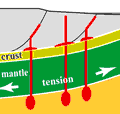 |
Tectonic implications of Early Miocene OIB magmatism in a near-trench setting: the Outer Zone of SW Japan and the northernmost Ryukyu Islands |
Kazuo Kiminamia, Teruyoshi Imaokaa, Kazuki Ogurab, Hiroshi Kawabatac, Hideo Ishizukad & Yasushi Morie
aDepartment of Geosphere Sciences, Faculty of Science, Yamaguchi University, Yamaguchi 753-8512, Japan
bGraduate School of Integrated Arts and Sciences, Kochi University, Kochi 780-8520, Japan
cMultidisciplinary Science Cluster, Kochi University, Kochi 780-8520, Japan
dDepartment of Geology, Kochi University, Kochi 780-8520, Japan
eKitakyushu Museum of Natural History and Human History, 2-4-1 Higashida, Yahatahigashi-ku, Kitakyushu 805-0071, Japan
Corresponding author. Tel.: +81 83 933 5765; fax +81 83 933 5273
E-mail address: imaoka@yamaguchi-u.ac.jp (T. Imaoka)
This webpage is a summary of: Kiminami, K., Imaoka, T., Ogura, K., Kawabata, H., Ishizuka, H., and Mori, Y., 2017, Tectonic implications of Early Miocene OIB magmatism in a near-trench setting: the Outer Zone of SW Japan and the northernmost Ryukyu Islands: Journal of Asian Earth Sciences. 135, 291-302, doi: org/10.1016/j.jseaes.2016.12.033
1. Introduction
Miocene magmatism in SW Japan has previously been discussed with regard to subduction of the young Philippine Sea Plate (PSP) and opening of the Sea of Japan, which resulted in trench-ward motion of SW Japan. However, the influence of geodynamics on magmatism in the region is still debated (Kimura et al., 2005; 2014). Because of the position of the Neogene-Quaternary arc, Miocene magmatism in the Outer Zone of SW Japan is inferred to have occurred in the fore-arc region (e.g., Shinjoe, 1997). In the Outer Zone of SW Japan and the northernmost Ryukyu Islands, Early Miocene basalt and lamprophyre dikes with alkaline affinities have been reported from Shingu-Otoyo area in northern Shikoku (Uto et al., 1987) and from Tanegashima at the northern end of the Ryukyu Islands (Ogasawara, 1997) (Figure 1).
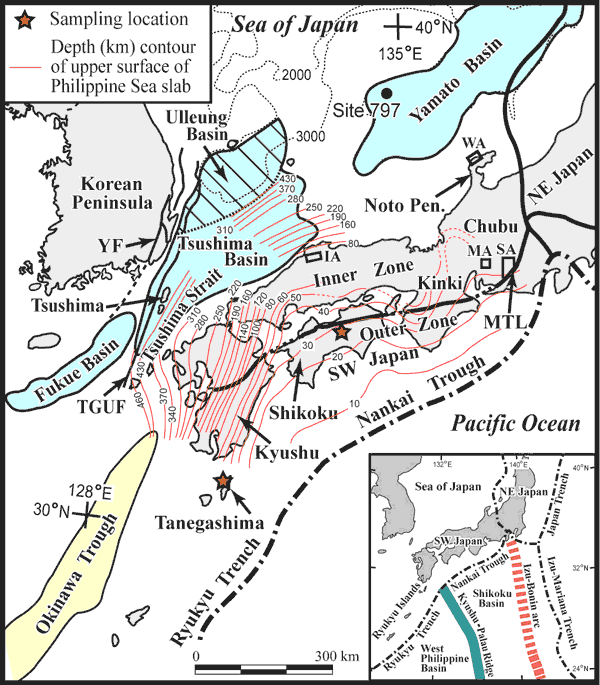
Figure 1: Map showing the locations of the SW Japan and Ryuku arcs, and associated tectonic and geographical features. Sampling locations are also shown, indicated by red stars. Inset map shows the location and tectonic setting of SW Japan. Depth contours to the upper boundary of the subducting Philippine Sea slab are after Hirose et al. (2008) and Huang et al. (2013). MTL = Median Tectonic Line; YF = Yangsan Fault; TGUF = Tsushima-Goto-Ulleung Fault; IA = Izumo area; MA = Mizunami area; SA = Shitara area; WA = Wajima area.
The occurrence of mafic dikes with alkaline affinities in a near-trench setting is unusual and enigmatic with regard to plate tectonic processes, because the subducting oceanic plate is presumed to have been shallow during the Early Miocene and would act as a barrier to magma rising vertically from great depth. Here, we discuss the timing of the trench-ward motion of SW Japan, its effect on the geometry of the subducting slab, and the tectonic implications of the presence of mafic dikes with alkaline affinities in the near-trench environment during the Early Miocene.
2. Geological background
The SW Japan and Ryukyu arcs are divided by the Median Tectonic Line (MTL) into the Inner and Outer zones. The Outer Zone is underlain mainly by late Paleozoic to Cenozoic accretionary complexes and post-Paleogene igneous rocks. The following tectonostratigraphic units of the accretionary complexes occur from north to south (Figure 2):
- the high-P/T type Sanbagawa Metamorphic Belt; upper Paleozoic to Jurassic accretionary complexes (the Chichibu Belt); and
- Cretaceous-Cenozoic accretionary complexes (the Shimanto Belt).
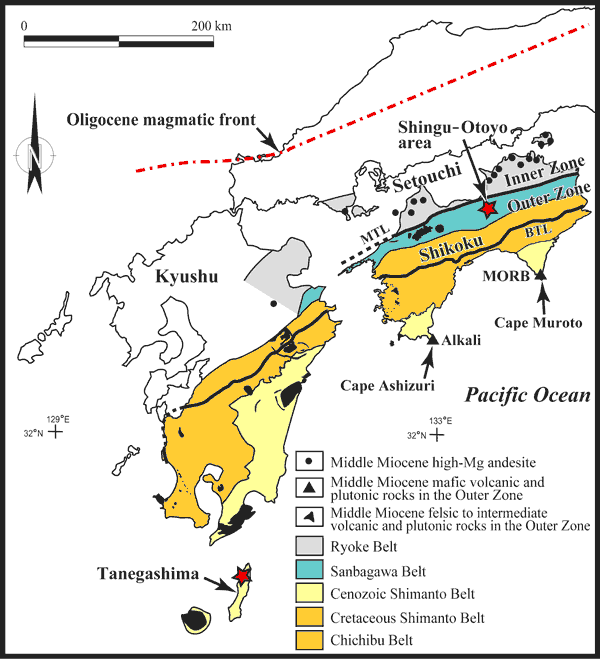
Figure 2: Map showing the occurrences of Middle Miocene igneous rocks in the Outer Zone and Setouchi area (compiled from Uto et al., 1997; Kimira et al., 2005, etc.) and sampling locations in the Shingu-Otoyo area and Tanegashima, and the geotectonic divisions of the Outer Zone. The location of the Oligocene magmatic front is after Sakai (1994) and Imaoka et al. (2011). MTL = Median Tectonic Line; BTL = Butsuzo Tectonic Line.
It is well known that Middle Miocene felsic to intermediate volcano-plutonic complexes occur in the Outer Zone from central Japan to the Ryukyu Islands. The basaltic dike in the Shingu-Otoyo area yields a well-defined 40Ar/36Ar-400K/36Ar isochron age of 17.7 ± 0.5 Ma (Uto et al., 1987) and contains microdiamond-bearing peridotite xenoliths (Mizukami et al., 2008). The Tanegashima lamprophyre gives a hornblende K-Ar age of 18.2 ± 0.9 Ma (Ogasawara, 1997). This Early Miocene mafic magmatism pre-dates the felsic-to-intermediate magmatism in the Outer Zone.
3. Whole-rock chemistry
The Shingu-Otoyo basalts and the Tanegashima lamprophyre show high concentrations of HFSEs, e.g., TiO2 = 1.9-2.1 wt.% and 2.5-3.4 wt.%, respectively, Nb = 51-60 ppm and 50-55 ppm, respectively, Ta = 3.4- 4.3 ppm and 3.4-3.9 ppm, respectively, and Zr = 168-219 ppm and 209-275 ppm, respectively. Figure 3 shows a recently proposed NbN vs. ThN discrimination diagram (after Saccani, 2015) that enables basalts generated at divergent plate and within-plate settings to be distinguished from basalts generated at convergent plate settings. The Shingu-Otoyo basalts and Tanegashima lamprophyre plot near the average ocean island basalt (OIB) composition (Sun & McDonough, 1989) in the alkaline OIB field, which confirms the OIB nature of these rocks.
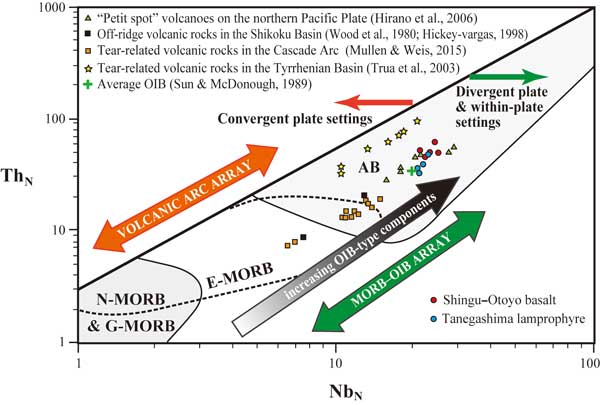
Figure 3: NbN vs. ThN diagram (Saccani, 2015) showing data of the Shingu-Otoyo alkaline basalts and Tanegashima lamprophyre. Th and Nb are normalized to the N-MORB composition of Sun & McDonough (1989).
4. Discussion
4.1. Timing of the extensional regime and opening of the western part of the Sea of Japan
On the basis of Miocene paleomagnetic data from SW Japan, Hoshi & Sano (2013) and Hoshi et al. (2015) concluded that clockwise rotation of SW Japan occurred predominantly during the interval 17.5-15.8 Ma. This conclusion is consistent with that obtained from geochronological and paleomagnetic data from Miocene rocks in central SW Japan by Sawada et al. (2013). We adopt the hypothesis of Hoshi et al. (2015) for the timing of clockwise rotation of SW Japan.
Numerous studies (e.g., Kano et al., 2007; Ninomiya et al., 2014; Yoon et al., 2014) concerning geochronology, geochemistry, and tectonic regime in and around the western part of the Sea of Japan have revealed that an extensional regime in the region commenced during the early stage of the Early Miocene, if not before. We presume that the clockwise rotation of SW Japan was preceded by the onset of extensional tectonics in the western part of the Sea of Japan.
The timing of extensional tectonics in the western part of the Sea of Japan is an important factor in determining the nature of the boundary between the Eurasian Plate and the PSP because extensional tectonics with the trench-ward motion of SW Japan would have induced convergence between the both plates. Thus, we suggest that the PSP has been subducted since the Early Miocene.
4.2. Configuration of the subducting PSP and the overriding plate during the Early Miocene
Present-day depths to the top of the subducting slab are ~30-35 km (Hirose et al., 2008; Ito et al., 2009) around the Shingu-Otoyo area, and ~40 km at Tanegashima (Hirose et al., 2008). It is reasonable to assume that these depths are greater than those during the Miocene, because of subsequent accretion. Present-day crustal-scale cross sections illustrate a direct contact between the Shimanto accretionary complex and the subducting slab, with no lower crust and mantle wedge beneath much of the Outer Zone in Shikoku (Igarashi et al., 2011). Thus, it is highly likely that the crust, consisting predominantly of the Shimanto accretionary complex, was coupled with the top of the subducting Philippine Sea slab beneath most of the Outer Zone in the western part of SW Japan and the northernmost Ryukyu Islands during the Early Miocene. Alternatively, if there was a mantle wedge it was very thin and would have been restricted to the northern margin of the Outer Zone.
Statistical analyses of modern subduction zones, analogue experiments, and numerical simulations indicate that trench-ward motion of the overriding plate leads to shallowing of the angle of subduction (e.g., Heuret et al., 2007). It is well known that the present-day PSP is being underthrust beneath Shikoku at a low angle (Hirose et al., 2008; Huang et al., 2013). In contrast, the subduction angle of the PSP beneath the northernmost Ryukyu arc is higher than that beneath Shikoku. Some authors have proposed that the slab beneath the northernmost Ryukyu arc steepened to its modern geometry after 4 Ma (e.g., Watanabe, 2005) suggesting shallower subduction during the Miocene. We envisage that the Early Miocene trench-ward motion of SW Japan produced a shallowly dipping slab.
4.3. OIB-type magmatism related to “petit spots” or a slab tear in the near-trench environment
The Early Miocene configuration of the subducting and overriding plates allows us to attribute the mafic magmatism with OIB signatures to the upwelling of asthenospheric mantle from beneath the subducting slab, through pathways such as fractures or tears. The cause of the fractures or tears remains unknown, but we propose the following two plausible scenarios. First, the shallowing of the subducted PSP would have caused the slab to flex concavely, as shown in Figure 4a. Concave-upward bending of the subducting plate may have led to brittle fracturing parallel to the hinge line in the flexed region. This could have led to subsequent upwelling of asthenospheric mantle through the fractures, in a similar manner to that illustrated by Hirano et al. (2006).
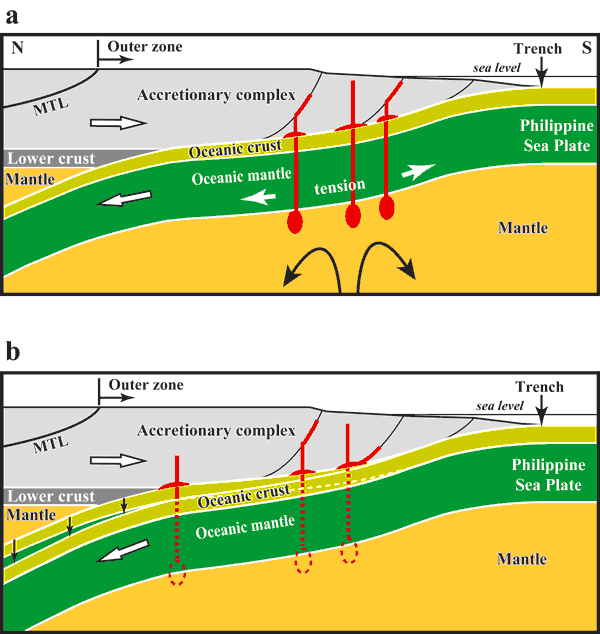
Figure 4: Schematic diagrams showing two possible scenarios (a and b) that could explain the alkaline mafic magmatism in the Outer Zone of the SW Japan and northernmost Ryukyu arcs. In scenario a, shallowing of the subducted PSP causes the slab to flex in a concave-upwards manner, which leads to brittle fracturing parallel to the hinge line and subsequent upwelling of asthenospheric mantle through the fractures. Scenario b involves segmentation of the down-going Philippine Sea slab through slab tearing, induced by differential motion within the slab, and subsequent upwelling of asthenospheric mantle through the tears. Vertical arrows in figure b show the differential motion of the subducting slab.
The second scenario involves vertical tears of the subducting slab. Some authors have suggested segmentation of the down-going PSP through slab tearing or fracturing beneath SW Japan (e.g., Huang et al., 2013; Cao et al., 2014). In general, slab tearing induces the upwelling of asthenospheric mantle from beneath/behind the slab. We suggest that vertical tearing of the subducting Philippine Sea slab, induced by one or more of the mechanisms, along with brittle fracturing caused by flexure of the slab, played an important role in the formation of OIB-type alkaline magmas during the Early Miocene (Figure 4b).
Vertical tears and fractures in an oceanic plate or subducting slab produce coeval magmatic rocks with OIB signatures. In Figure 3, NbN and ThN values of the Early Miocene mafic dikes from the Outer Zone are compared with those of off-ridge alkaline basalts in the Shikoku Basin (Hickey-Vargas, 1998), alkaline basalts from “petit spot” volcanoes (Hirano et al., 2006), vertical-tear-related alkaline basalts from the Southern Tyrrhenian Basin (Trua et al., 2003) and the Garibaldi Volcanic Belt in the northern Cascade Arc (Mulllen & Weis, 2015). Most lavas originating from off-ridge magmatism in the Pacific Ocean show N-MORB or E-MORB geochemical signatures (e.g., Geshi et al., 2007). The Early Miocene basalts and lamprophyre fall in the same field as alkaline basalts from “petit spot” volcanoes. Tear-related alkaline lavas from the Southern Tyrrhenian Basin have higher ThN values for a given NbN value compared with the samples from the alkaline Shingu-Otoyo basalts and the Tanegashima lamprophyre. This is in agreement with the involvement of a subduction-related component in the genesis of alkaline lavas from the Southern Tyrrhenian Basin, as noted by Trua et al. (2003). Tear-related volcanic rocks from the Garibaldi Volcanic Belt fall largely in the AB field, and display somewhat lower enrichments of OIB-type components than the samples from the Early Miocene mafic dikes in the Outer Zone. Thus, we favor the idea that the Early Miocene OIB magmatism in the near-trench environment of the SW Japan and northernmost Ryukyu arcs occurred in response to “petit spot” or slab-tear-induced magmatism.
5. Conclusions
The Early Miocene OIB-type magmatism in the near-trench environment of the SW Japan and northernmost Ryukyu arcs is most plausibly explained by the upwelling of asthenospheric material from beneath the subducting slab, which migrated through fractures and/or tears in the slab. The fractures or tears may have formed via two mechanisms:
- a shallowing of the dip of the subducting PSP, which would have resulted in concave-upward flexure of the slab, thereby generating fractures in the flexed region; or
- differential motion within the subducting slab, which would have induced slab tearing and segmentation.
References
-
Cao, L., Wang, Z., Wu, S., Gao, X., 2014. A new model of slab tear of the subducting Philippine Sea Plate associated with Kyushu-Palau Ridge subduction. Tectonophysics 636, 158-169.
-
Geshi, N., Umino, S., Kumagai, H., Sinton, J.M., White, S.M., Kishimoto, K., Hilde, T.W., 2007. Discrete plumbing systems and heterogeneous magma sources of a 24 km3 off-axis lava field on the western flank of East Pacific Rise, 14°S. Earth and Planetary Science Letters 258, 61-72.
-
Heuret, A., Funiciello, F., Faccenna, C., Lallemand, S., 2007. Plate kinematics, slab shape and back-arc stress: a comparison between laboratory models and current subduction zones. Earth and Planetary Science Letters 256, 473-783.
-
Hickey-Vargas, R., 1998. Origin of the Indian Ocean-type isotopic signature in basalts from Philippine Sea plate spreading centers: An assessment of local versus large-scale processes. Journal of Geophysical Research 103, 20963-20979.
-
Hirano, N., Takahashi, E., Yamamoto, J., Abe, N., Ingle, S.P., Kaneoka, I., Hirata, T., Kimura, J.-I., Ishii, T., Ogawa, Y., Machida, S., Suyehiro, K., 2006. Volcanism in response to plate flexure. Science 313, 1426-1428.
-
Hirose, F., Nakajima, J., Hasegawa, A., 2008. Three-dimensional seismic velocity structure and configuration of the Philippine Sea slab in southwestern Japan estimated by double-difference tomography. Journal of Geophysical Research 13, B09315, doi:10.1029/2007JB005274.
-
Hoshi, H., Kato, D., Ando, Y., Nakashima, K., 2015. Timing of clockwise rotation of Southwest Japan: constraints from new middle Miocene paleomagnetic results. Earth, Planets and Space 67, doi: 10.1186/s40623-015-0266-3.
-
Hoshi, H., Sano, M. 2013. Paleomagnetic constraints on Miocene rotation in the central Japan Arc. Island Arc 22, 197-213.
-
Huang, Z., Zhao, D., Hasegawa, A., Umino, N., Park, J.-H., Kang, I.-B., 2013. Aseismic deep subduction of the Philippine Sea plate and slab window. Journal of Asian Earth Sciences 75, 82-94.
-
Igarashi, T., Iidaka, T., Miyabayashi, S., 2011. Crustal structure in the Japanese Islands inferred from receiver function analysis. Zishin. Journal of the Seismological Society of Japan 63, 139-151 (in Japanese with English abstract).
-
Imaoka, T., Kiminami, K., Nishida, K., Takemoto, M., Ikawa, T., Itaya, T., Kagami, H., Iizumi, S., 2011. K-Ar age and geochemistry of the SW Japan Paleogene cauldron cluster: Implications for Eocene-Oligocene thermo-tectonic reactivation. Journal of Asian Earth Sciences 40, 509-533.
-
Ito, T., Kojima, Y., Kodaira, S., Sato, H., Kaneda, Y., Iwasaki, T., et al., 2009. Crustal structure of southwest Japan, revealed by the integrated seismic experiment Southwest Japan 2002. Tectonophysics 472, 124-134.
-
Kano, K., Uto, K., Ohguchi, T., 2007. Stratigraphic review of Eocene to Oligocene successions along the eastern Japan Sea: Implication for early opening of the Japan Sea. Journal of Asian Earth Sciences 30, 20-32.
-
Kimura, G., Hashimoto, Y., Kitamura, Y., Yamaguchi, A., Koge, H., 2014. Middle Miocene swift migration of the TTT triple junction and rapid crustal growth in southwest Japan: A review. Tectonics 33, doi:10.1002/2014TC003531.
-
Kimura, J-I., Stern, R.J., Yoshida, T., 2005. Reinitiation of subduction and magmatic responses in SW Japan during Neogene time. Geological Society of America Bulletin 117, 969-986.
-
Mizukami, T., Wallis, S., Enami, M., Kagi, H., 2008. Forearc diamond from Japan. Geology 36, 219-222.
-
Mullen, E.K., Weis, D., 2015. Evidence for trench-parallel mantle flow in the northern Cascade Arc from basalt geochemistry. Earth and Planetary Science Letters 414, 100-107.
-
Ninomiya, T., Shimoyama, S., Watanabe, K., Horie, K., Dunkley, D.J., Shiraishi, K., 2014. Age of the Taishu Group, southwestern Japan, and implications for the origin and evolution of the Japan Sea. Island Arc 23, 206-220.
-
Ogasawara, M., 1997. K-Ar age and geochemical characteristics of the quartz-porphyry at Shimama, southern Tanegashima, and K-Ar age of a lamprophyre from northern Tanegashima: implications for Miocene igneous activities in the Outer Zone of Southwest Japan. Journal of Mineralogy, Petrology and Economic Geology 92, 454-464 (in Japanese with English abstract).
-
Saccani, E., 2015. A new method of discriminating different types of post-Archean ophiolitic basalts and their tectonic significance using Th-Nb and Ce-Dy-Yb systematics. Geoscience Frontiers 6, 481-501.
-
Sakai, H., 1994. Koinoura pyroclastic deposits in the Lower Oligocene Tsuyazaki Formation, North Kyushu. The Journal of Geological Society of Japan 100, 692-708.
-
Sawada, Y., Mishiro, Y., Imaoka, T., Yoshida, K., Inada, R., Hisai, K., Kondo, H., Hyodo, M., 2013. K-Ar ages and paleomagnetism of the Miocene in the Izumo Basin, Shimane Prefecture. The Journal of the Geological Society of Japan 119, 267-284 (in Japanese with English abstract).
-
Shinjoe, H., 1997. Origin of the granodiorite in the forearc region of southwest Japan: Melting of the Shimanto accretionary prism. Chemical Geology 134, 237-255.
-
Sun, S.S., McDonough, W.F., 1989. Chemical and isotopic systematic of oceanic basalts: implications for mantle composition and processes. In: Saunders, A.D., Norry, M. J. (Eds.), Magmatism in the Ocean Basins. Geological Society of London, Special Publication 42, 313-345.
-
Trua, T., Serri, G., Marani, M., 2003. Lateral flow of African mantle below the nearby Tyrrhenian plate: geochemical evidence. Terra Nova 15, 433-440.
-
Uto, K., Goto, K., Arai, S., 1987. K-Ar ages of carbonate and mantle nodule-bearing lamprophyre dikes from Shingu, central Shikoku, southwest Japan. Geochemical Journal 28, 431-449.
-
Watanabe, Y., 2005. Late Cenozoic evolution of epithermal gold metallogenic provinces in Kyushu, Japan. Mineralium Deposita 40, 307-323.
-
Yoon, S.H., Sohn, Y.K., Chough, S.K., 2014. Tectonic, sedimentary, and volcanic evolution of a back-arc basin in the East Sea (Sea of Japan). Marine Geology 352, 70-88.
last updated 25th September, 2017 |
